The Full Join (Also known as Full Outer join) includes the rows from both the tables. Wherever the rows do not match a null value is assigned to every column of the table that does not have a matching row. A Full join looks like a Right Join & Left Join combined together in one query. This article explores the Full join in more detail with examples
Syntax
The syntax of the Full join is as follows
1 2 3 4 5 6 | SELECT <Columns> FROM tableA FULL JOIN tableB ON (join_condition) |
The join_condition defines the condition on which the tables are joined.
All the rows from both the tables are included in the final result. A NULL value is assigned to every column of the table that does not have a matching row based on the join condition.
The FULL OUTER JOIN & FULL JOIN are the same. The Keyword OUTER is optional
1 2 3 4 5 6 | SELECT <Columns> FROM tableA FULL OUTER JOIN tableB ON (join_condition) |
Full Join
The Full join can be better explained with the following Venn diagram
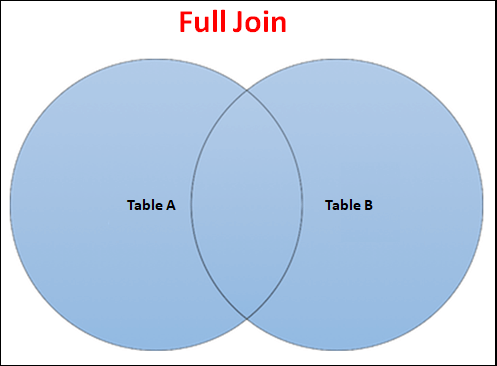
The circles in the above diagram represent the two tables. Table A and Table B, which we would like to join using the full join. The intersection part in the above picture shows the data rows which satisfy the join condition.
The full join of the above tables returns
- The matching rows from both tables
- All the unmatched rows from Table A with null for columns from Table B
- All the unmatched rows from Table B with null for columns from Table A
Full Join Example
Now, let us see the full join using a real-life example
Sample database
Consider the following tables from the table reservation system of a restaurant. You can use the following script to create the database
CustomerType : Type of Customer like VIP / Regular etcCustomers List of customers with Customer Type.Tables The list of tables available in the restaurant. CustomerID field indicates that the customer has reserved the table.Orders : The orders placed by the customerDiscVoucher The discounts slab based on the total value of the order
[tabby title=”–Sample database–“]
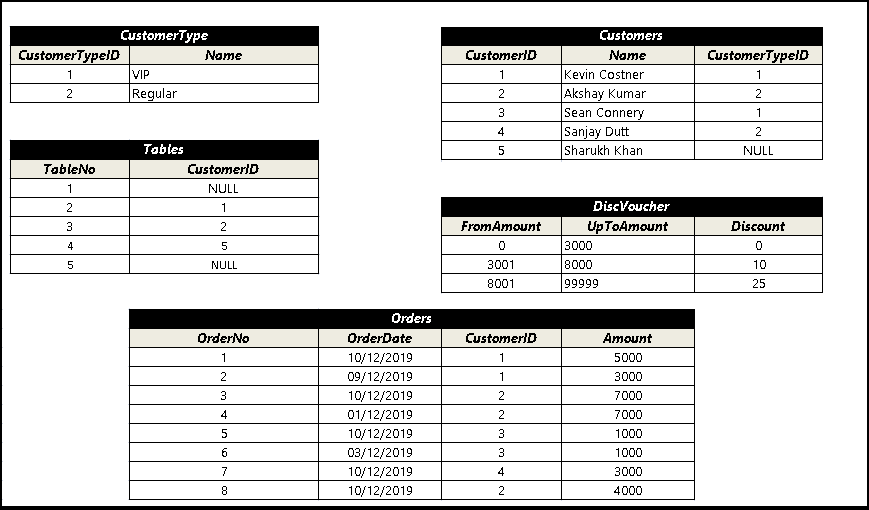
[tabby title=”–SQL Query–“]
1 2 3 4 5 6 7 8 9 10 11 12 13 14 15 16 17 18 19 20 21 22 23 24 25 26 27 28 29 30 31 32 33 34 35 36 37 38 39 40 41 42 43 44 45 46 47 48 49 50 51 52 53 54 55 56 57 58 59 60 61 62 63 64 65 66 67 | create table customerType ( CustomerTypeID int primary key, Name varchar(10) ) insert into customerType values (1,'VIP') insert into customerType values (2,'Regular') create table Customers ( CustomerID int primary key, Name varchar(100), CustomerTypeID int null, CONSTRAINT FK_Customers_CustomerTypeID FOREIGN KEY (CustomerTypeID) REFERENCES customerType (CustomerTypeID) ); insert into Customers values(1, 'Kevin Costner',1); insert into Customers values(2, 'Akshay Kumar',2); insert into Customers values(3, 'Sean Connery',1); insert into Customers values(4, 'Sanjay Dutt',2); insert into Customers values(5, 'Sharukh Khan',null); create table Tables ( TableNo int primary key, CustomerID int null, CONSTRAINT FK_Tables_CustomerID FOREIGN KEY (CustomerID) REFERENCES Customers (CustomerID) ); insert into Tables values(1, null); insert into Tables values(2, 1); insert into Tables values(3, 2); insert into Tables values(4, 5); insert into Tables values(5, null); create table Orders ( OrderNo int primary key, OrderDate datetime, CustomerID int null, Amount decimal(10,2), CONSTRAINT FK_Orders_CustomerID FOREIGN KEY (CustomerID) REFERENCES Customers (CustomerID) ); insert into Orders Values(1,'2019-12-10',1,5000) insert into Orders Values(2,'2019-12-09',1,3000) insert into Orders Values(3,'2019-12-10',2,7000) insert into Orders Values(4,'2019-12-01',2,7000) insert into Orders Values(5,'2019-12-10',3,1000) insert into Orders Values(6,'2019-12-03',3,1000) insert into Orders Values(7,'2019-12-10',4,3000) insert into Orders Values(8,'2019-12-10',2,4000) create table DiscVoucher ( FromAmount decimal(10,0) , UptoAmount decimal(10,0) , Discount decimal(10,0) ) insert into DiscVoucher Values(0,3000,0) insert into DiscVoucher Values(3001,8000,10) insert into DiscVoucher Values(8001,99999,25) |
[tabbyending]
Query
The following query joins the customers with the tables
1 2 3 4 5 6 | Select C.CustomerID,C.Name, T.TableNo From Customers C full join Tables T on (C.CustomerID=T.CustomerID) |
The above query returns all the customers & all the tables. The result shows
- Customers who have booked the tables (matching rows)
- Customers who have not reserved the table. The Table No column has NULL Value
- Unreserved tables. The customerID & Name column has NULL Values
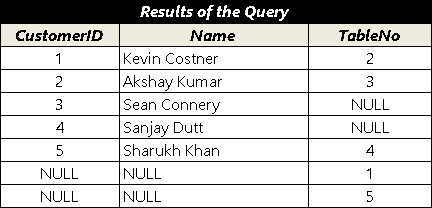
Where clause
By filtering out the results where CustomerID is null, it will return all the customers with reserved tables. The result is similar to what you get when you use the Left Join
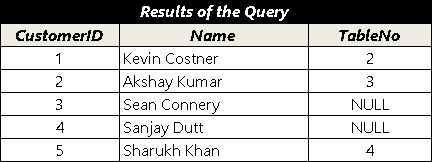
1 2 3 4 5 6 7 | Select C.CustomerID,C.Name, T.TableNo From Customers C full join Tables T on (C.CustomerID=T.CustomerID) where C.CustomerID is not null |
Similarly, by filtering out the result where Table No is null, the query will return the list of tables with the customer who booked it. The result is similar to Right Join
1 2 3 4 5 6 7 | Select C.CustomerID,C.Name, T.TableNo From Customers C full join Tables T on (C.CustomerID=T.CustomerID) where T.TableNo is not null |
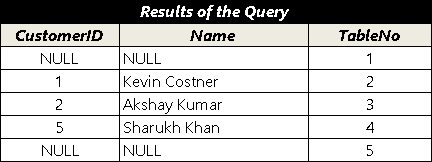
Finally, filtering out both null customers and tableNo, you will get the result which is what you get when you use inner join
1 2 3 4 5 6 7 8 | Select C.CustomerID,C.Name, T.TableNo From Customers C full join Tables T on (C.CustomerID=T.CustomerID) where C.CustomerID is not null and T.TableNo is not null |
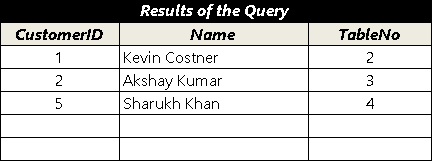
References
Summary
Full Join is a very rarely used compared to the other join types. It joins both the tables on a join condition but includes unmatched rows from both the tables into a single result set.


